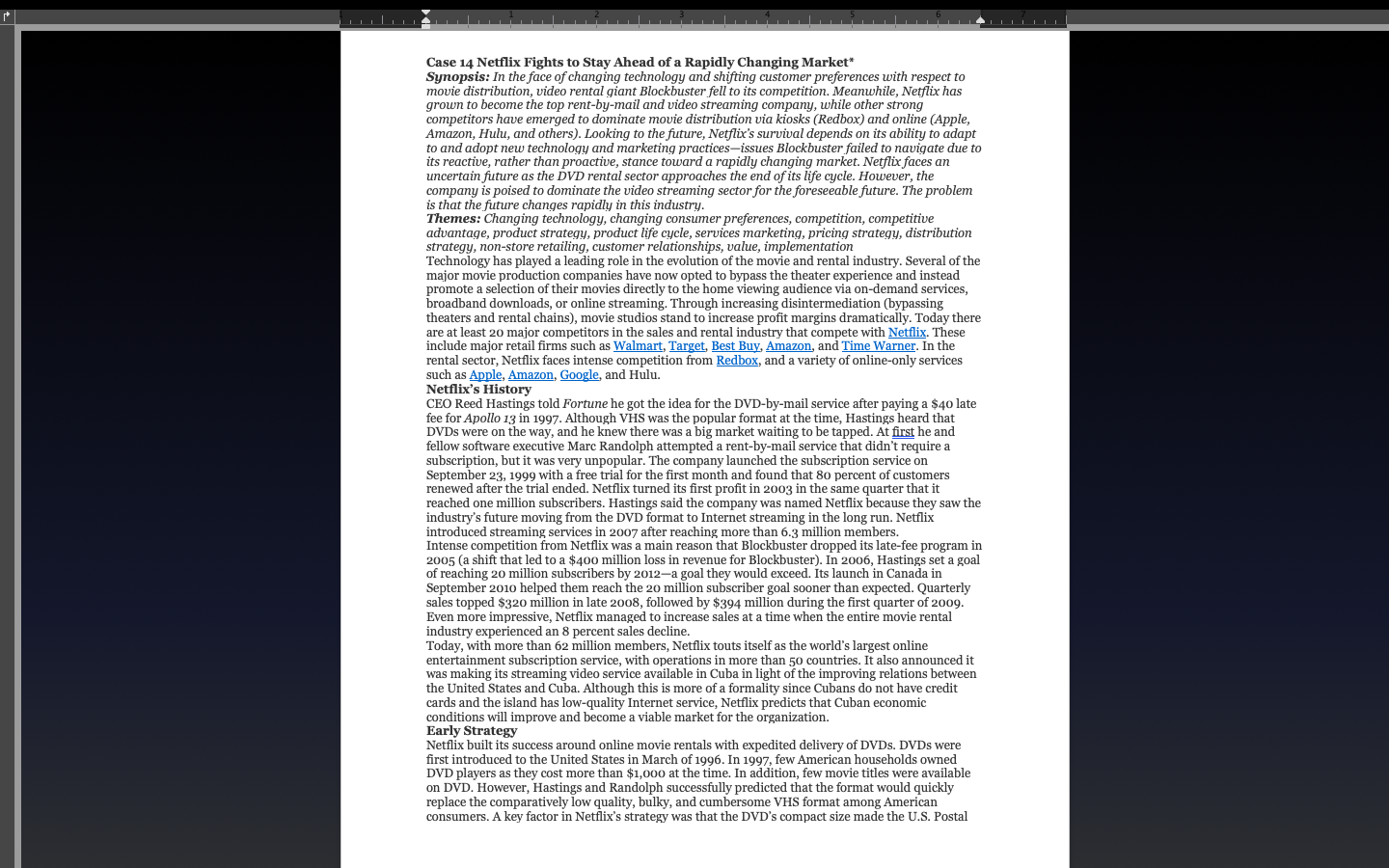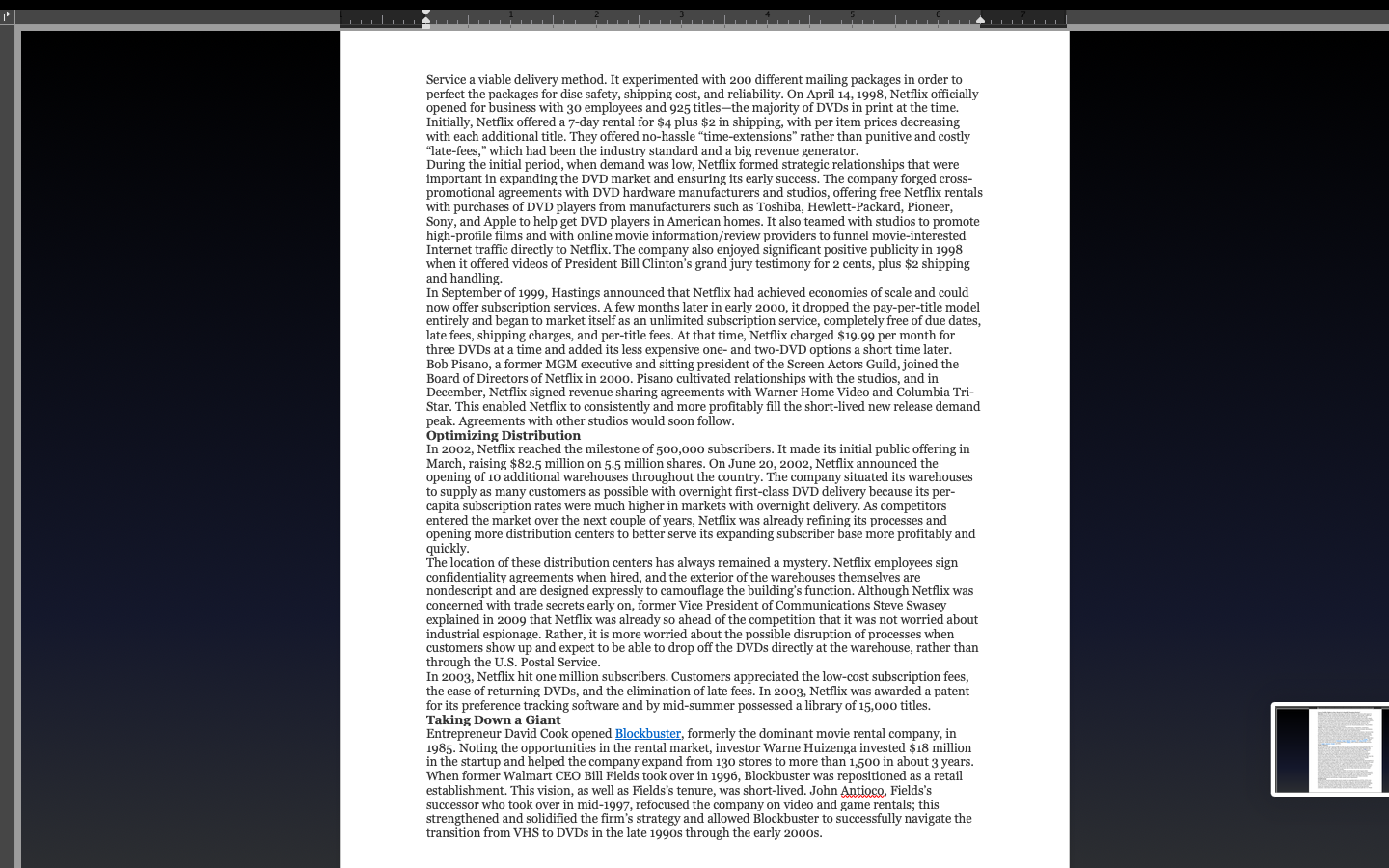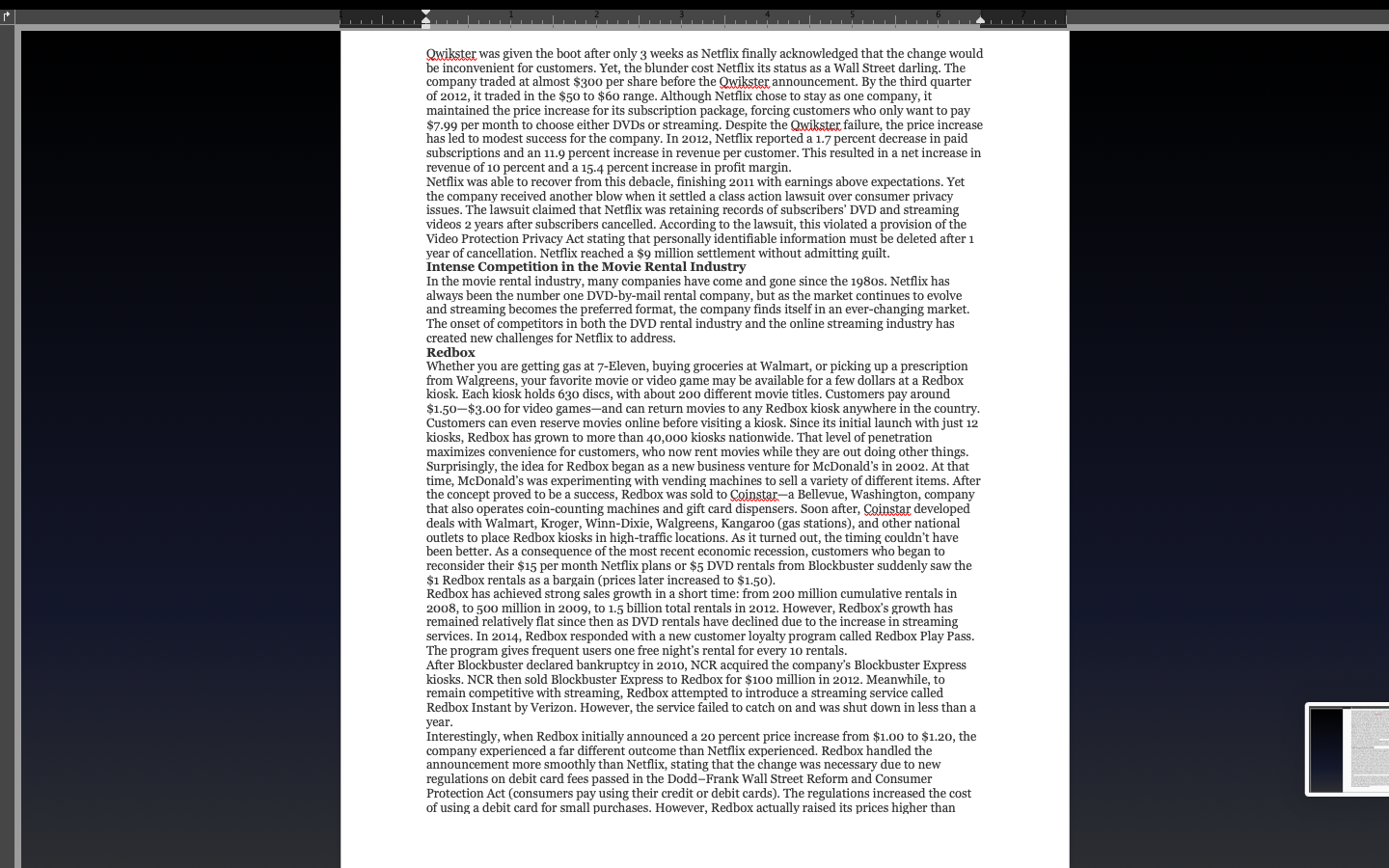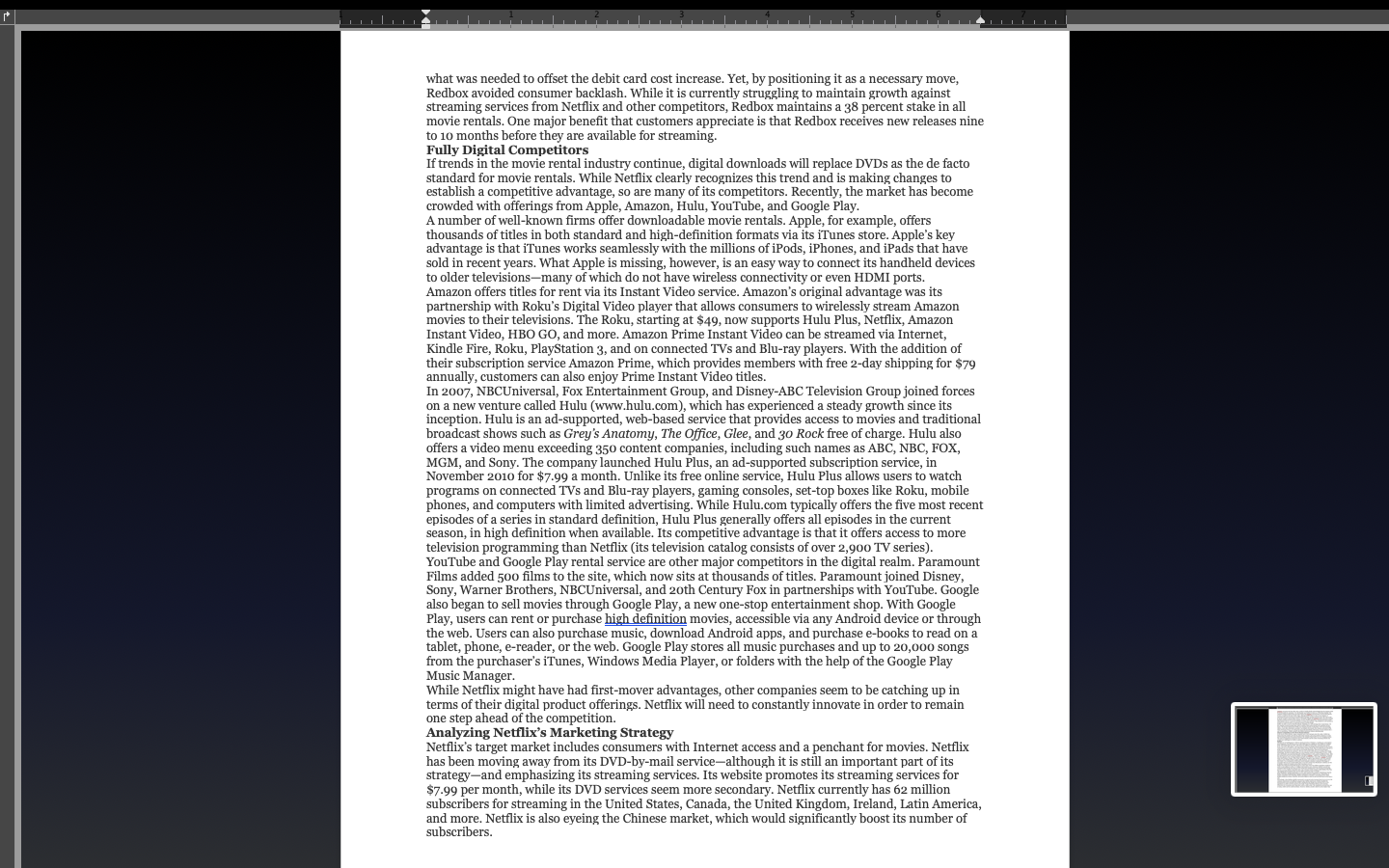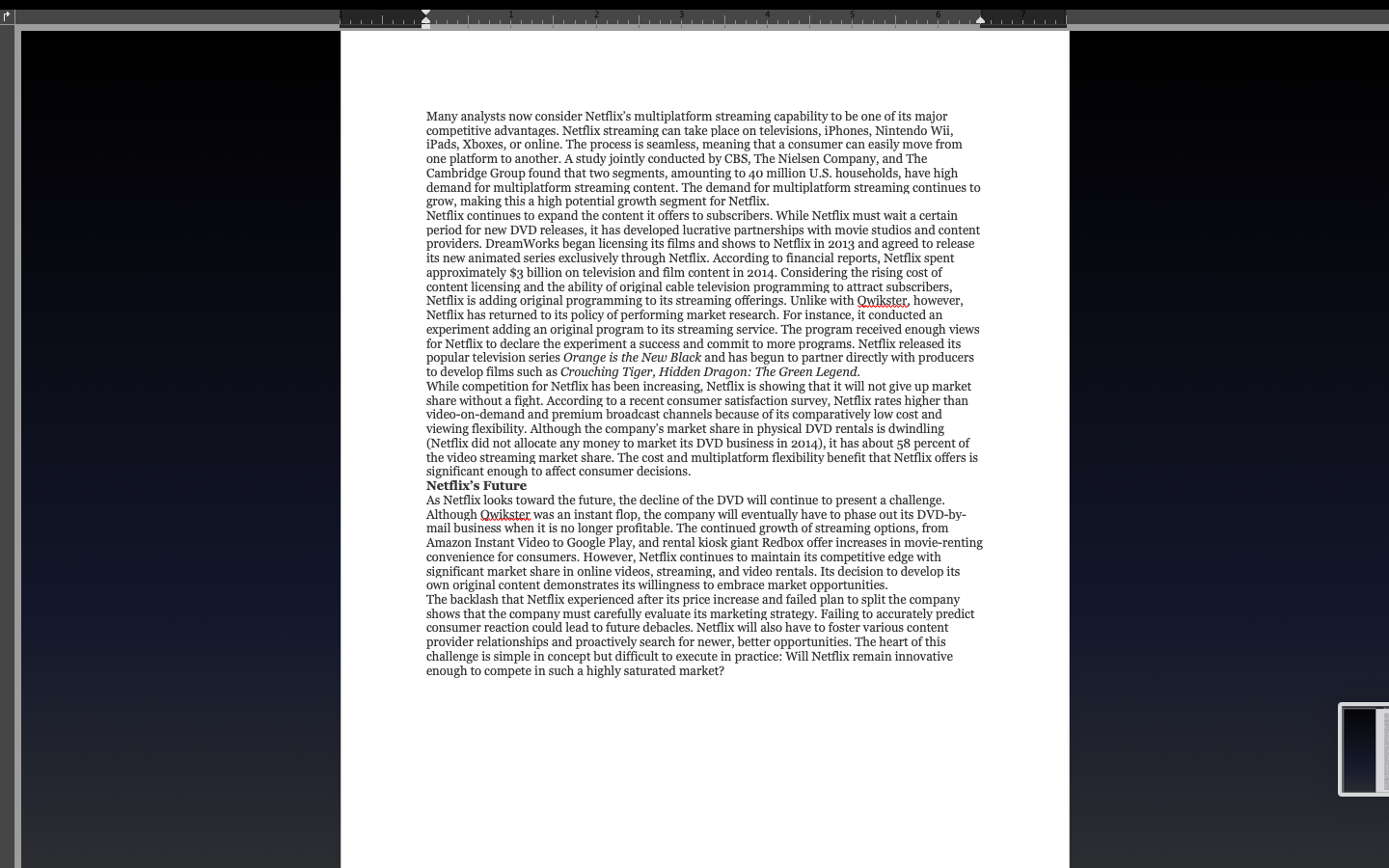Answer the following question using your own words. ( Original work please)
Reading will be down below
1: What role will Redbox play in the development of Netflix's strategic plans? How threatening is Redbox to Netflix's future?
2: How will new competition from digital content providers force Netflix to alter its strategy?
3: What new opportunities do you see in the movie streaming business, or the entertainment industry as a whole?
4: Do you think Netflix will remain the dominant force in both streaming and movie rentals? Why or why not?
5: What could Netflix have done differently to ensure Qwikster's success?
Case 14 Netflix Fights to Stay Ahead of a Rapidly Changing Market* Synopsis: In the face of changing technology and shifting customer preferences with respect to movie distribution, video rental giant Blockbuster fell to its competition. Meanwhile, Netflix has grown to become the top rent-by-mail and video streaming company, while other strong competitors have emerged to dominate movie distribution via kiosks (Redbox) and online (Apple, Amazon, Hulu, and others). Looking to the future, Netflix's survival depends on its ability to adapt to and adopt new technology and marketing practices-issues Blockbuster failed to navigate due to its reactive, rather than proactive, stance toward a rapidly changing market. Netflix faces an uncertain future as the DVD rental sector approaches the end of its life cycle. However, the company is poised to dominate the video streaming sector for the foreseeable future. The problem is that the future changes rapidly in this industry. Themes: Changing technology, changing consumer preferences, competition, competitive advantage, product strategy, product life cycle, services marketing, pricing strategy, distribution strategy, non-store retailing, customer relationships, value, implementation Technology has played a leading role in the evolution of the movie and rental industry. Several of the major movie production companies have now opted to bypass the theater experience and instead promote a selection of their movies directly to the home viewing audience via on-demand services, broadband downloads, or online streaming. Through increasing disintermediation (bypassing theaters and rental chains), movie studios stand to increase profit margins dramatically. Today there are at least 20 major competitors in the sales and rental industry that compete with Netflix. These include major retail firms such as Walmart, Target, Best Buy, Amazon, and Time Warner. In the rental sector, Netflix faces intense competition from Redbox, and a variety of online-only services such as Apple, Amazon, Google, and Hulu. Netflix's History CEO Reed Hastings told Fortune he got the idea for the DVD-by-mail service after paying a $40 late fee for Apollo 13 in 1997. Although VHS was the popular format at the time, Hastings heard that DVDs were on the way, and he knew there was a big market waiting to be tapped. At first he and fellow software executive Marc Randolph attempted a rent-by-mail service that didn't require a subscription, but it was very unpopular. The company launched the subscription service on September 23, 1999 with a free trial for the first month and found that 80 percent of customers renewed after the trial ended. Netflix turned its first profit in 2003 in the same quarter that it reached one million subscribers. Hastings said the company was named Netflix because they saw the industry's future moving from the DVD format to Internet streaming in the long run. Netflix introduced streaming services in 2007 after reaching more than 6.3 million members. Intense competition from Netflix was a main reason that Blockbuster dropped its late-fee program in 2005 (a shift that led to a $400 million loss in revenue for Blockbuster). In 2006, Hastings set a goal of reaching 20 million subscribers by 2012-a goal they would exceed. Its launch in Canada in September 2010 helped them reach the 20 million subscriber goal sooner than expected. Quarterly sales topped $320 million in late 2008, followed by $394 million during the first quarter of 2009. Even more impressive, Netflix managed to increase sales at a time when the entire movie rental industry experienced an 8 percent sales decline. Today, with more than 62 million members, Netflix touts itself as the world's largest online entertainment subscription service, with operations in more than 50 countries. It also announced it was making its streaming video service available in Cuba in light of the improving relations between the United States and Cuba. Although this is more of a formality since Cubans do not have credit cards and the island has low-quality Internet service, Netflix predicts that Cuban economic conditions will improve and become a viable market for the organization. Early Strategy Netflix built its success around online movie rentals with expedited delivery of DVDs. DVDs were first introduced to the United States in March of 1996. In 1997, few American households owned DVD players as they cost more than $1,000 at the time. In addition, few movie titles were available on DVD. However, Hastings and Randolph successfully predicted that the format would quickly replace the comparatively low quality, bulky, and cumbersome VHS format among American consumers. A key factor in Netflix's strategy was that the DVD's compact size made the U.S. PostalService a viable delivery method. It experimented with 200 different mailing packages in order to perfect the packages for disc safety, shipping cost, and reliability. On April 14, 1998, Netflix officially opened for business with 30 employees and 925 titles-the majority of DVDs in print at the time Initially, Netflix offered a 7-day rental for $4 plus $2 in shipping, with per item prices decreasing with each additional title. They offered no-hassle "time-extensions" rather than punitive and costly "late-fees," which had been the industry standard and a big revenue generator. During the initial period, when demand was low, Netflix formed strategic relationships that were important in expanding the DVD market and ensuring its early success. The company forged cross- promotional agreements with DVD hardware manufacturers and studios, offering free Netflix rentals with purchases of DVD players from manufacturers such as Toshiba, Hewlett-packard, Pioneer, Sony, and Apple to help get DVD players in American homes. It also teamed with studios to promote high-profile films and with online movie information/review providers to funnel movie-interested Internet traffic directly to Netflix. The company also enjoyed significant positive publicity in 1998 when it offered videos of President Bill Clinton's grand jury testimony for 2 cents, plus $2 shipping and handling. In September of 1999, Hastings announced that Netflix had achieved economies of scale and could now offer subscription services. A few months later in early 2000, it dropped the pay-per-viewodel entirely and began to market itself as an unlimited subscription service, completely free of due dates, late fees, shipping charges, and per-title fees. At that time, Netflix charged $19.99 per month for three DVDs at a time and added its less expensive one- and two-DVD options a short time later. Bob Pisano, a former MGM executive and sitting president of the Screen Actors Guild, joined the Board of Directors of Netflix in 2000. Pisano cultivated relationships with the studios, and in December, Netflix signed revenue sharing agreements with Warner Home Video and Columbia Tri- Star. This enabled Netflix to consistently and more profitably fill the short-lived new release demand peak. Agreements with other studios would soon follow. Optimizing Distribution In 2002, Netflix reached the milestone of 500,000 subscribers. It made its initial public offering in March, raising $82.5 million on 5.5 million shares. On June 20, 2002, Netflix announced the opening of 10 additional warehouses throughout the country. The company situated its warehouses to supply as many customers as possible with overnight first-class DVD delivery because its per- capita subscription rates were much higher in markets with overnight delivery. As competitors entered the market over the next couple of years, Netflix was already refining its processes and opening more distribution centers to better serve its expanding subscriber base more profitably and quickly. The location of these distribution centers has always remained a mystery. Netflix employees sign confidentiality agreements when hired, and the exterior of the warehouses themselves are nondescript and are designed expressly to camouflage the building's function. Although Netflix was concerned with trade secrets early on, former Vice President of Communications Steve Swasey explained in 2009 that Netflix was already so ahead of the competition that it was not worried about industrial espionage. Rather, it is more worried about the possible disruption of processes when customers show up and expect to be able to drop off the DVDs directly at the warehouse, rather than through the U.S. Postal Service. In 2003, Netflix hit one million subscribers. Customers appreciated the low-cost subscription fees the ease of returning DVDs, and the elimination of late fees. In 2003, Netflix was awarded a patent for its preference tracking software and by mid-summer possessed a library of 15,000 titles. Taking Down a Giant Entrepreneur David Cook opened Blockbuster, formerly the dominant movie rental company, in 1985. Noting the opportunities in the rental market, investor Warne Huizenga invested $18 million in the startup and helped the company expand from 130 stores to more than 1,500 in about 3 years. When former Walmart CEO Bill Fields took over in 1996, Blockbuster was repositioned as a retail establishment. This vision, as well as Fields's tenure, was short-lived. John Antioco, Fields's successor who took over in mid-1997, refocused the company on video and game rentals; this strengthened and solidified the firm's strategy and allowed Blockbuster to successfully navigate the transition from VHS to DVDs in the late 1990s through the early 2000s.The home entertainment business continued to evolve, and Blockbuster's revised mission was to be "the complete resource for movies and games. " Recognizing the growing threat posed by Netflix, Blockbuster began to experiment with a nonsubscription online rental service with a postal delivery component in the United Kingdom. Most of Blockbuster's success during this period was attributed to its successful positioning as the market leader, combined with strong growth trends in the gaming industry. In 2004, Blockbuster finally entered the online movie rental business in a bid to compete more directly with increasingly competitive Netflix. However, Blockbuster continued its focus on its bricks-and-mortar stores by offering online renters the option of two free in-store rentals each month, designed to cater to impulse home entertainment demand. The mix of in-store rentals and Blockbuster's new online offering was considered a competitive advantage over Netflix. Antioco unexpectedly left Blockbuster in 2007 and was replaced by James Keys, previously the "turnaround artist" for 7-Eleven. When Keyes began as CEO, Blockbuster was facing serious difficulties: its stock price had fallen more than 83 percent in the years between 2002 and 2007, and it had made the strategic decision to close nearly 300 stores in both 2007 and 2008. Netflix had quickly become one of Blockbuster's most serious competitors. Due to competition from Netflix, Blockbuster chose to drop its late fees; this resulted in an astounding $400 million loss for Blockbuster, as well as legal problems. Even as the movie rental industry began to lose its growth trajectory and move into the decline phase, Netflix enjoyed strong growth. Netflix's advantages over Blockbuster's offerings included renters' access to an unlimited number of movies upon subscribing; convenient, automatic, and free shipping once a movie is returned via the postal service; extremely fast turnaround; and a broad distribution network. In the end, Blockbuster failed to adapt to the changing market and declared bankruptcy in 2010 after facing $1 billion in debt. That same year, Netflix reached 20 million members, up 63 percent from 2009, and launched services in Canada. Blockbuster was eventually purchased by Dish Network, but this failed to save the firm. Blockbuster shuttered its final 300 stores, although it continued offering Blockbuster on Demand video streaming Netflix Changes Its Business Model Netflix CEO Reed Hastings correctly anticipated the new technology entering the home entertainment industry. A study from IHS Screen Digest suggested that by 2012, online movie streaming in the United States would exceed both DVD and Blu-ray use. Hastings expected that Netflix's DVD subscriptions would decline steadily over each quarter as new technology diffused into consumers' homes. At that point, Hastings made a strategic decision that he would later regret. In 2011, Netflix attempted to move its DVD-by-mail business into a new subsidiary called Qwikster that would focus solely on DVD-by-mail services. This move would free Netflix to focus on the streaming side of the operation. While this supported Hastings's vision of an all-streaming future, it led to a price increase of 60 percent and took away the convenient and valued one-stop shopping experience for subscribers who used both DVD-by-mail and streaming. Netflix suddenly announced the decision to split the services in 2011. Ironically, in the past, Netflix had used focus groups to research how the market might respond to a particular decision. This time, however, Netflix relied on data showing that 75 percent of consumers preferred streaming. While this data is likely true, it failed to account for how consumers would react to the change. In addition to splitting into two companies, Netflix announced a price increase for one of its most popular subscription packages. Instead of paying $9.99 per month to receive movies either via streaming or DVD-by-mail service, interchangeably, customers would now pay $7.99 per month for each service. Netflix implemented the price adjustment and started the process of spinning off Qwikster in August 2011. The customer backlash was swift and dramatic. Customers were angry at what they perceived to be a drastic price increase. The outrage worsened after e-mails were sent to Netflix subscribers containing an apology from Hastings for not explaining the reasoning behind raising prices. The e-mail also announced the splitting of the two companies. Rather than placating customers, many became angrier. They did not like the idea of moving between two websites-Qwikster for DVDs and Netflix for streaming. The company lost 405,000 paid subscribers in a matter of weeks. Investors doubted the move, and Netflix's stock price plummeted by 26 percent in a single day following the release of the third-quarter financial report.Qwikster was given the boot after only 3 weeks as Netflix finally acknowledged that the change would be inconvenient for customers. Yet, the blunder cost Netflix its status as a Wall Street darling. The company traded at almost $300 per share before the Qwikster announcement. By the third quarter of 2012, it traded in the $50 to $60 range. Although Netflix chose to stay as one company, it maintained the price increase for its subscription package, forcing customers who only want to pay $7.99 per month to choose either DVDs or streaming. Despite the Qwikster failure, the price increase has led to modest success for the company. In 2012, Netflix reported a 1.7 percent decrease in paid subscriptions and an 11.9 percent increase in revenue per customer. This resulted in a net increase in revenue of 10 percent and a 15-4 percent increase in profit margin Netflix was able to recover from this debacle, finishing 2011 with earnings above expectations. Yet the company received another blow when it settled a class action lawsuit over consumer privacy issues. The lawsuit claimed that Netflix was retaining records of subscribers' DVD and streaming videos 2 years after subscribers cancelled. According to the lawsuit, this violated a provision of the Video Protection Privacy Act stating that personally identifiable information must be deleted after 1 year of cancellation. Netflix reached a $9 million settlement without admitting guilt. Intense Competition in the Movie Rental Industry In the movie rental industry, many companies have come and gone since the 1980s. Netflix has always been the number one DVD-by-mail rental company, but as the market continues to evolve and streaming becomes the preferred format, the company finds itself in an ever-changing market. The onset of competitors in both the DVD rental industry and the online streaming industry has created new challenges for Netflix to address. Redbox Whether you are getting gas at 7-Eleven, buying groceries at Walmart, or picking up a prescription from Walgreens, your favorite movie or video game may be available for a few dollars at a Redbox kiosk. Each kiosk holds 630 discs, with about 200 different movie titles. Customers pay around $1.50-$3.00 for video games-and can return movies to any Redbox kiosk anywhere in the country. Customers can even reserve movies online before visiting a kiosk. Since its initial launch with just 12 kiosks, Redbox has grown to more than 40,000 kiosks nationwide. That level of penetration maximizes convenience for customers, who now rent movies while they are out doing other things. Surprisingly, the idea for Redbox began as a new business venture for Mcdonald's in 2002. At that time, Mcdonald's was experimenting with vending machines to sell a variety of different items. After the concept proved to be a success, Redbox was sold to Coinstar-a Bellevue, Washington, company that also operates coin-counting machines and gift card dispensers. Soon after, Coinstar developed deals with Walmart, Kroger, Winn-Dixie, Walgreens, Kangaroo (gas stations), and other national outlets to place Redbox kiosks in high-traffic locations. As it turned out, the timing couldn't have been better. As a consequence of the most recent economic recession, customers who began to reconsider their $15 per month Netflix plans or $5 DVD rentals from Blockbuster suddenly saw the $1 Redbox rentals as a bargain (prices later increased to $1.50). Redbox has achieved strong sales growth in a short time: from 200 million cumulative rentals in 2008, to 500 million in 2009, to 1.5 billion total rentals in 2012. However, Redbox's growth has remained relatively flat since then as DVD rentals have declined due to the increase in streaming services. In 2014, Redbox responded with a new customer loyalty program called Redbox Play Pass. The program gives frequent users one free night's rental for every 10 rentals. After Blockbuster declared bankruptcy in 2010, NCR acquired the company's Blockbuster Express kiosks. NCR then sold Blockbuster Express to Redbox for $100 million in 2012. Meanwhile, to remain competitive with streaming, Redbox attempted to introduce a streaming service called Redbox Instant by Verizon. However, the service failed to catch on and was shut down in less than a year. Interestingly, when Redbox initially announced a 20 percent price increase from $1.00 to $1.20, the company experienced a far different outcome than Netflix experienced. Redbox handled the announcement more smoothly than Netflix, stating that the change was necessary due to new regulations on debit card fees passed in the Dodd-Frank Wall Street Reform and Consumer Protection Act (consumers pay using their credit or debit cards). The regulations increased the cost of using a debit card for small purchases. However, Redbox actually raised its prices higher thanwhat was needed to offset the debit card cost increase. Yet, by positioning it as a necessary move, Redbox avoided consumer backlash. While it is currently struggling to maintain growth against streaming services from Netflix and other competitors, Redbox maintains a 38 percent stake in all movie rentals. One major benefit that customers appreciate is that Redbox receives new releases nine to 10 months before they are available for streaming. Fully Digital Competitors If trends in the movie rental industry continue, digital downloads will replace DVDs as the de facto standard for movie rentals. While Netflix clearly recognizes this trend and is making changes to establish a competitive advantage, so are many of its competitors. Recently, the market has become crowded with offerings from Apple, Amazon, Hulu, YouTube, and Google Play A number of well-known firms offer downloadable movie rentals. Apple, for example, offers thousands of titles in both standard and high-definition formats via its iTunes store. Apple's key advantage is that iTunes works seamlessly with the millions of iPods, iPhones, and iPads that have sold in recent years. What Apple is missing, however, is an easy way to connect its handheld devices to older televisions-many of which do not have wireless connectivity or even HDMI ports. Amazon offers titles for rent via its Instant Video service. Amazon's original advantage was its partnership with Roku's Digital Video player that allows consumers to wirelessly stream Amazon movies to their televisions. The Roku, starting at $49, now supports Hulu Plus, Netflix, Amazon Instant Video, HBO GO, and more. Amazon Prime Instant Video can be streamed via Internet Kindle Fire, Roku, PlayStation 3, and on connected TVs and Blu-ray players. With the addition of their subscription service Amazon Prime, which provides members with free 2-day shipping for $79 annually, customers can also enjoy Prime Instant Video titles. In 2007, NBCUniversal, Fox Entertainment Group, and Disney-ABC Television Group joined forces on a new venture called Hulu (www.hulu.com), which has experienced a steady growth since its inception. Hulu is an ad-supported, web-based service that provides access to movies and traditional broadcast shows such as Grey's Anatomy, The Office, Glee, and 30 Rock free of charge. Hulu also offers a video menu exceeding 350 content companies, including such names as ABC, NBC, FOX, MGM, and Sony. The company launched Hulu Plus, an ad-supported subscription service, in November 2010 for $7.99 a month. Unlike its free online service, Hulu Plus allows users to watch programs on connected TVs and Blu-ray players, gaming consoles, set-top boxes like Roku, mobile phones, and computers with limited advertising. While Hulu.com typically offers the five most recent episodes of a series in standard definition, Hulu Plus generally offers all episodes in the current season, in high definition when available. Its competitive advantage is that it offers access to more television programming than Netflix (its television catalog consists of over 2,900 TV series) YouTube and Google Play rental service are other major competitors in the digital realm. Paramount Films added 500 films to the site, which now sits at thousands of titles. Paramount joined Disney, Sony, Warner Brothers, NBCUniversal, and 20th Century Fox in partnerships with YouTube. Google also began to sell movies through Google Play, a new one-stop entertainment shop. With Google Play, users can rent or purchase high definition movies, accessible via any Android device or through the web. Users can also purchase music, download Android apps, and purchase e-books to read on a tablet, phone, e-reader, or the web. Google Play stores all music purchases and up to 20,000 songs from the purchaser's iTunes, Windows Media Player, or folders with the help of the Google Play Music Manager. While Netflix might have had first-mover advantages, other companies seem to be catching up in terms of their digital product offerings. Netflix will need to constantly innovate in order to remain one step ahead of the competition. Analyzing Netflix's Marketing Strategy Netflix's target market includes consumers with Internet access and a penchant for movies. Netflix has been moving away from its DVD-by-mail service-although it is still an important part of its strategy-and emphasizing its streaming services. Its website promotes its streaming services for $7.99 per month, while its DVD services seem more secondary. Netflix currently has 62 million subscribers for streaming in the United States, Canada, the United Kingdom, Ireland, Latin America, and more. Netflix is also eyeing the Chinese market, which would significantly boost its number of subscribers.Many analysts now consider Netflix's multiplatform streaming capability to be one of its major competitive advantages. Netflix streaming can take place on televisions, iPhones, Nintendo Wii, iPads, Xboxes, or online. The process is seamless, meaning that a consumer can easily move from one platform to another. A study jointly conducted by CBS, The Nielsen Company, and The Cambridge Group found that two segments, amounting to 40 million U.S. households, have high demand for multiplatform streaming content. The demand for multiplatform streaming continues to grow, making this a high potential growth segment for Netflix. Netflix continues to expand the content it offers to subscribers. While Netflix must wait a certain period for new DVD releases, it has developed lucrative partnerships with movie studios and content providers. DreamWorks began licensing its films and shows to Netflix in 2013 and agreed to release its new animated series exclusively through Netflix. According to financial reports, Netflix spent approximately $3 billion on television and film content in 2014. Considering the rising cost of content licensing and the ability of original cable television programming to attract subscribers, Netflix is adding original programming to its streaming offerings. Unlike with Qwikster, however, Netflix has returned to its policy of performing market research. For instance, it conducted an experiment adding an original program to its streaming service. The program received enough views for Netflix to declare the experiment a success and commit to more programs. Netflix released its popular television series Orange is the New Black and has begun to partner directly with producers to develop films such as Crouching Tiger, Hidden Dragon: The Green Legend. While competition for Netflix has been increasing, Netflix is showing that it will not give up market share without a fight. According to a recent consumer satisfaction survey, Netflix rates higher than video-on-demand and premium broadcast channels because of its comparatively low cost and viewing flexibility. Although the company's market share in physical DVD rentals is dwindling (Netflix did not allocate any money to market its DVD business in 2014), it has about 58 percent of the video streaming market share. The cost and multiplatform flexibility benefit that Netflix offers is significant enough to affect consumer decisions. Netflix's Future As Netflix looks toward the future, the decline of the DVD will continue to present a challenge. Although Qwikster was an instant flop, the company will eventually have to phase out its DVD-by- mail business when it is no longer profitable. The continued growth of streaming options, from Amazon Instant Video to Google Play, and rental kiosk giant Redbox offer increases in movie-renting convenience for consumers. However, Netflix continues to maintain its competitive edge with significant market share in online videos, streaming, and video rentals. Its decision to develop its own original content demonstrates its willingness to embrace market opportunities. The backlash that Netflix experienced after its price increase and failed plan to split the company shows that the company must carefully evaluate its marketing strategy. Failing to accurately predict consumer reaction could lead to future debacles. Netflix will also have to foster various content provider relationships and proactively search for newer, better opportunities. The heart of this challenge is simple in concept but difficult to execute in practice: Will Netflix remain innovative enough to compete in such a highly saturated market
